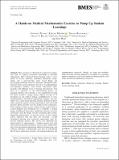A Hands-on Medical Mechatronics Exercise to Pump Up Student Learnings
Author(s)
Pennes, Anthony; Mendez, Keegan; Hanumara, Nevan; Roche, Ellen T.; Traverso, Giovanni; Custer, David; Hom, Gim; ... Show more Show less
Download43683_2022_Article_100.pdf (2.884Mb)
Publisher with Creative Commons License
Publisher with Creative Commons License
Creative Commons Attribution
Terms of use
Metadata
Show full item recordAbstract
Abstract
Best practices in Biomedical Engineering education seek to connect classroom knowledge to practical applications. MIT’s Medical Device Design course is comprised of in-class didactics, individual laboratory assignments, and a semester-long, team- based design and prototyping challenge, based in real unmet biomedical need. Students in the course represent a broad set of undergraduate and graduate students, from diverse educational backgrounds, with different levels of training and expertise. This year, as a precursor to the semester-long project, we designed, piloted, and evaluated a new experiential learning lab based around a syringe pump, selected because of its prevalence in the clinical setting, exemplification of core, multidisciplinary biomedical engineering concepts, and suitability for a team-based learning exercise. Students individually calculated patient dosing requirements and translated desired volume and flow rate into stepper motor commands. Then, during a single in-class session, teams worked from a custom-designed and fabricated kit to assemble a syringe pump, breadboard electronics, implement software controls, and finally close the design loop by evaluating their pumps' dispensing performance. A post-lab survey of the student cohort indicated that this pilot lab provided a sound biomedical learning and teamwork opportunity that improved technical literacy. The survey also identified key opportunities for improvement – students wanted more time and instructor-guided learning to increase their understanding of the mechanical engineering, electrical engineering, and software subtopics. Consequently, next year we will expand the lab into a multi-class exercise, with enhanced lectures and supplementary materials. Overall, we share this problem-based learning exercise, designed to exemplify key concepts, improve teamwork, and foster hands-on tinkering skills, with other biomedical engineering instructors.
Date issued
2023-01-19Department
Massachusetts Institute of Technology. Department of Electrical Engineering and Computer Science; Massachusetts Institute of Technology. Institute for Medical Engineering & Science; Massachusetts Institute of Technology. Department of Mechanical EngineeringPublisher
Springer International Publishing
Citation
Pennes, Anthony, Mendez, Keegan, Hanumara, Nevan, Roche, Ellen T., Traverso, Giovanni et al. 2023. "A Hands-on Medical Mechatronics Exercise to Pump Up Student Learnings."
Version: Final published version